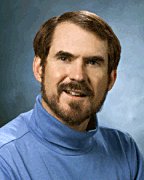Reprinted from Massage Today,
January
2001 (Vol. 1, Num. 1)
P.O. Box 6070 Huntington Beach, CA 92615 •USA
 |
|
The RamblemuseSMKeith Eric Grant, Ph.D. |
Beginnings and Visions
Beginnings are both challenges and opportunities, whether the beginning of a new massage practice or of a new column about massage. Beginnings prompt us both to review where we have been and to extend ourselves in new directions. As this column begins, I invite you to participate in the journey with me and, by your feedback, to influence its course.
What I bring to this column is my personal Ramblemuse soup of background and perspectives. During the past eight years, I have been teaching sports and deep tissue massage and further exploring nuances of orthopedic techniques. My interest in these particular venues of massage stems in part from my own varied movement experiences as a dancer, runner, ice-skater, and student of martial arts and partly from a desire to know how to relieve pain and improve other's abilities to move effectively. Interwoven with these experiences is my background as a physicist and researcher. During the same eight years, I have also been constantly active in Internet based discussions of massage education and governance. Coupled with some earlier background in Ericksonian hypnosis and the use of metaphor, these discussions have propelled me into learning about the educational psychology of multiple intelligences and diversity in learning styles. As this column progresses, I will be drawing topics from these backgrounds of technique, movement, and educational psychology. To begin, however, I want to consider some very basic concepts of human interaction — nonverbal communication and congruence.
What we accomplish with our massage clients is often done as much from our effects on mind and nervous system as from our direct effects on tissue. We are not just technicians of touch but communicators. By our activities, we are acting to integrate healthy touch back into a culture that has become blatantly afraid of touch and the interpersonal intimacy and connection it brings. When we enter into the practice of massage, we consciously or unconsciously, willingly or unwillingly, take on the mantle of kinesthetic role models for our clients and acquaintances. We often will convey more to them via our body language, tone of voice, and overall attitudes toward touch and the human body than we will by our words and printed forms. It is for these reasons that we must face and know intimately the names of our own dragons if we are to achieve the greatest benefit for our clients.
These unconscious dragons often begin to surface as beginning massage students face a quality and quantity of touch for which, in some cases, they were little prepared. For most, this creates of state of growth and transformation that is life affirming. For some, however, the classroom issues of emotional projection and transference originating from prior negative experiences and unresolved traumas can become a block to effective learning and practice. In these cases, there are issues that must be dealt with in therapy beyond the boundaries of the massage class.
Our beliefs, internal dialogs, and mental visualizations have great impact on what we continually project and communicate via our nonverbal responses of gesture, posture, tempo of movement, and tone of voice. When our conscious and unconscious beliefs are in accord, our verbal and nonverbal messages will be congruent. Our clients can not help but perceive this. When we act with internal conflict or with our awareness unfocused, our clients will tend to believe our bodies rather than our words. In martial arts, we are trained to change our state of awareness as we enter and leave the place of practice. Part of this is a discipline for showing respect and appreciation for the place, participants, and tradition. Another element, however, is in developing the habit of leaving our personal issues off the mat along with our shoes. I encourage my massage students and myself to remember to leave our unresolved emotions at the door as we prepare to begin a massage. Unlike baggage at an airport, they will still be there for us to reclaim (should we still need them) on our way out.
A couple of years ago, Public Radio International used the following story as part of their promotion on a new program on world events (http://www.theworld.org/).
One evening when a father came home from work, his children immediately wanted to play with him. “Whoa”, said the father. “I need a little time to sit and read my newspaper”. On the back page of the paper, was a large picture of the world. The father tore this into many pieces and handed it to the children, “Put the picture of the world back together, and when you are done I will play with you”, he said. A few minutes later the children were done. “How did you do that so quickly?” asked the father. “It was easy”, replied the children. “On the back of the world there were pictures of many people. When we put the people back together, the world came right!”
One of my visions for massage is that through the exercise of meaningful touch we can help to make the world come right. As we help people to reintegrate their body, mind, and spirit, we also facilitate them in acting with greater compassion and awareness. While each contribution may be small, the totality of all the contributions can be great. One of the things that this presupposes is that we each, on entering massage, must commit ourselves to a life-path of learning and self-congruity. In order to become kinesthetic role models for our clients, we each must seek to heal and reintegrate within ourselves. This reintegration can not be measured in classroom hours, but only in moments of connection and awareness.